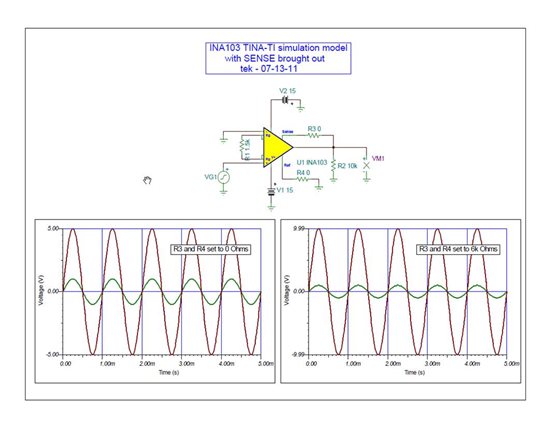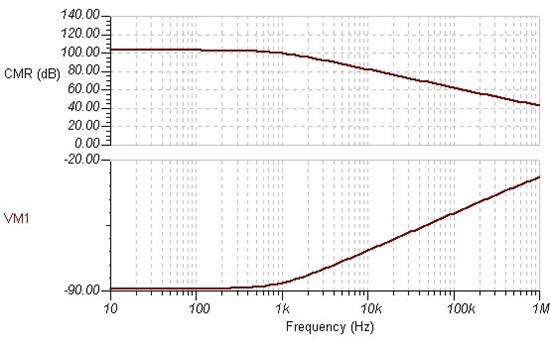i cant change the node list to match TI pinout
thanks
Martin
my file is posted there:
http://forum.designsoftware.com/index.php/topic,269.0.html
This thread has been locked.
If you have a related question, please click the "Ask a related question" button in the top right corner. The newly created question will be automatically linked to this question.
Martin,
The macromodel that TI has created for the INA103 has only ten (external) nodes - the model assumes that -Gain Sense is connected to -RG, and +Gain Sense is connected to +RG. It further assumes that Sense is connected to the Output. There is no provision for modeling the Offset Null pins, nor are the Gain Drive pins brought out. For most applications, this model does what most people would want for this device - as those default connections are how it is usually hooked up. Does your application require something more, or are you only concerned that the numbers of pins don't match?
im trying to print the design on a pcb, and im getting a 16 dip trace without the proper connection.
thanks
Martin
here is the pict
martin_gagnon dot tripod.com/images/INASCHE.JPG
martin_gagnon dot tripod.com/images/PINNODE.JPG
I'm sorry, I can't see the pictures, but the model is different from the actual package. Are you trying to lay out the PCB in TINA Industrial? You may have to ask DesignSoft for their suggestion on how to deal with this. There may be a way to create a new schematic symbol for TINA that would allow you to use their PCB package, but I'm afraid we can't be much help there - TINA-TI doesn't have the PCB capabilities and we don't use them here ;-)
Hi Rick,
I think some people may want to add circuits between the Sense and Output pins, and since you have wired the Sense pin out, how about leave it open? and let the users make the connection as they want?
here is my question:
If I want to break the connection between the Sense and the Output, how to modify the model?
Best Regards,
Cary
Cary,
Sorry for taking so long in responding, but I needed a little help getting the model modified...
My colleague, Thomas Kuehl, has modified the model.
Macro model alone: 4075.INA103.TSM
TINA test schematic: 5001.INA103_test_01.TSC

We need to do a little work on this to be able to put it into the TINA-TI library, but we'll do this as soon as possible and will make it available as an update. Until then, you can either just copy the symbol out of the schematic and place it in your own, or use the .TSM file using Insert->Macro menu command.
Hope that helps -
Rick,
Thank you very much for the update. That's exactly what I need.
And thanks to your colleague Thomas. You did a great job.
Here I have another question about the model 1NA103:
According to the datasheet, the CMR should go stronger with a larger G factor. as shown below:
But the simulation in TINA showed us a reversed result, which is attached below:
VF2: G=1000
VF3: G=100
VF4: G=10
which one is right? datasheet or simulation?
Best regards,
Cary
sorry, the pictures are missing, now i uploaded them again.
According to the datasheet, the CMR should go stronger with a larger G factor. as shown below:
But the simulation in TINA showed us a reversed result, which is attached below:
VF2: G=1000
VF3: G=100
VF4: G=10
Cary,
What you've plotted is the AC response of the circuit, not the CMR. Those curves show you 20*log(VFx) plotted against frequency, where VFx is the output voltage from the amplifier.
Using the test circuit that I posted the other day, with the amplifier configured for a gain of 5, and 1V in, I get 5Vp out. If I then tie the two inputs together, what I'm interested in is how much signal comes out - that's VM1 in that circuit. But the CMR is the ratio of the output for a regular differential signal to the common mode signal output. So, to get the plots to look like you expect, use the post-processor and set up a new waveform with the equation 5/VM1, and plot that on a Linear-dB scale. Here's what I get:

Hope that makes sense. Good luck!